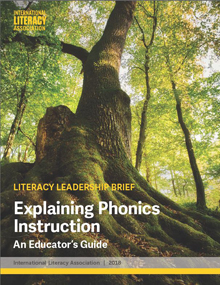 Despite ongoing debates over how to teach reading, research has proven that phonics instruction is an essential element of a comprehensive literacy program, according to ILA’s latest brief, Explaining Phonics Instruction: An Educator’s Guide. Phonics helps students to learn the written correspondences between letters, patterns of letters and sounds, leading to word knowledge.
Despite ongoing debates over how to teach reading, research has proven that phonics instruction is an essential element of a comprehensive literacy program, according to ILA’s latest brief, Explaining Phonics Instruction: An Educator’s Guide. Phonics helps students to learn the written correspondences between letters, patterns of letters and sounds, leading to word knowledge.
“Because phonics is often students’ first experience with formal literacy instruction,” states the brief, “families might be anxious about their children’s learning.” Educators can assuage these concerns by answering families’ questions and by providing effective at-home learning activities.
The brief shares research-based insights to explain the what, the when and the how of phonics instruction to noneducators, providing guidance on phonics for emerging readers, phonological awareness, the layers of writing, word study instruction, approaches to teaching phonics and teaching English learners.
Key takeaways include the following:
- Students should have acquired phonological awareness, concepts of print, concepts of word of text and alphabetic principles before beginning to learn phonics.
- Most phonics programs incorporate both analytic and synthetic activities.
- Word study is an approach to teach the alphabetic layer (basic letter–sound correspondences) and pattern layer (consonant–vowel patterns) of the writing system by including spelling instruction that is differentiated by students’ development.
- Phonics instruction depends on the characteristics of a specific language; students who learn to read in multiple languages apply phonics that fit the respective letter–sound, pattern, and meaning layers.
- Emergent bilingual readers and writers use their knowledge of one language to learn other languages.
To read more, visit the brief here.
Alina O'Donnell is the communications strategist at ILA and the editor of Literacy Daily.